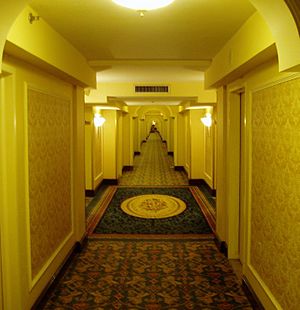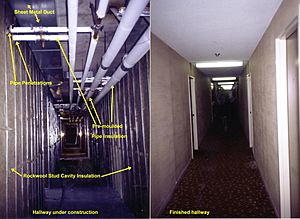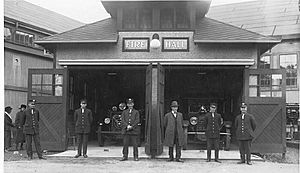Hall facts for kids



In architecture, a hall is a large space inside a building, covered by a roof and surrounded by walls. Long, narrow halls are often called corridors or hallways.
In ancient times, especially during the Iron Age and early Middle Ages in northern Europe, a mead hall was a big room. Here, a lord and his followers would eat, drink, and even sleep. Later in the Middle Ages, the great hall was the biggest room in castles and large homes. Servants often slept there.
As houses became more complex, the hall remained a large room. It was used for dancing, big feasts, and sometimes servants still slept there. It was usually right inside the main entrance. Today, in many homes, an entrance hall is still important. It's the space near the front door that leads to other rooms. If this space is long, it's called a passage, corridor, or hallway.
Contents
History of Halls
In places with warm weather, rich people often built their homes around an open courtyard. But in colder northern areas, large homes called manor houses were built around a great hall. This hall was the heart of the home. It had the fireplace, and everyone living there would eat, work, and sleep in this one big room. A good example of this kind of home is the longhouse. Only very messy jobs were done in separate small rooms.
Even today, the word hall is sometimes used to describe a country house. Examples include a hall house or a manor house.
In later medieval Europe, the main room of a castle or manor house was the great hall. This was where the fire was kept for warmth. As heating methods improved and people wanted more privacy, tasks moved to other rooms. First, the master of the house moved to private bedrooms and dining areas. Over time, servants and children also got their own spaces. Work projects were given their own rooms too. This left the hall mainly for special events. Its jobs as a dormitory (sleeping area), kitchen, or parlour (sitting room) were divided into separate rooms. Sometimes the kitchen was even in a separate building.
Until the early modern era, most people lived in houses with just one room. In the 1600s, even less wealthy people started to have a second room. The main room was still called the hall, and the second room was the parlor. This hall and parlor house design was common in England. It was a basic house plan in parts of the United States from 1620 to 1860.
Other Uses for Halls
University Halls
Many buildings at colleges and universities are called "_______ Hall." They are often named after the person who gave money to build them. For example, King's Hall, Cambridge is named after a king. Others, like Lady Margaret Hall, Oxford, honor respected people. Nassau Hall at Princeton University was once the only building of the college. In medieval times, these halls were where university members lived together. Some of this community spirit still remains today.
Some of these places are called "Hall" instead of "College." This is because when they were founded, they were not officially recognized as colleges. This might be because they were built before colleges existed. Or they might not have had the right official document from the king or queen. Examples at the University of Oxford include:
At the universities of Oxford and Cambridge, "Hall" also means the dining room for students. A special High Table is at one end for the teachers. For "Formal Hall" dinners, students often wear special gowns. For "informal Hall," they do not. These dining halls are like a changed version of the old Great hall.
Meeting Halls
A hall can also be a building with one main large room. This room is rented out for meetings and social events. It can be owned by a private company or the government. For example, a company might own a function hall for weddings. Or a village hall might be available for anyone to rent.
Religious Halls
In religious buildings, like those in Islamic architecture, a prayer hall is a large room. It is used for worship. An example is the prayer hall of the Great Mosque of Kairouan in Tunisia. A hall church is a church where the main part (nave) and side areas (aisles) are all about the same height. Many churches also have a church hall nearby. This hall is used for meetings and other church events.
Public Building Entrances
In office buildings and other large public places like theatres or cinemas, the entrance hall is usually called a foyer. The word atrium is sometimes used for the entrance hall in public buildings. In ancient Roman houses, the atrium was the central open courtyard.
Types of Halls
In architecture, a "double-loaded" corridor has rooms on both sides. A "single-loaded" corridor has rooms on only one side. It might have windows on the other side. A "blind corridor" doesn't lead anywhere.
Here are some common types of halls:
- Billiard hall (for playing billiards)
- City hall, town hall or village hall (where local government meets)
- Concert hall (for music performances)
- Concourse (a large open space in a transportation station)
- Convention center (often has exhibition halls for big events)
- Dance hall (for dancing)
- Dining hall (for eating meals)
- Firehall (where fire trucks are kept)
- Great room or great hall (a very large main room)
- Prayer hall (for religious worship)
- Reading room (for reading books)
- Residence hall (where students live at a college)
- Waiting room (in large transportation stations)
See also
 In Spanish: Recibidor para niños
In Spanish: Recibidor para niños




